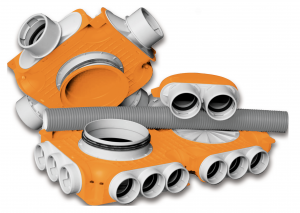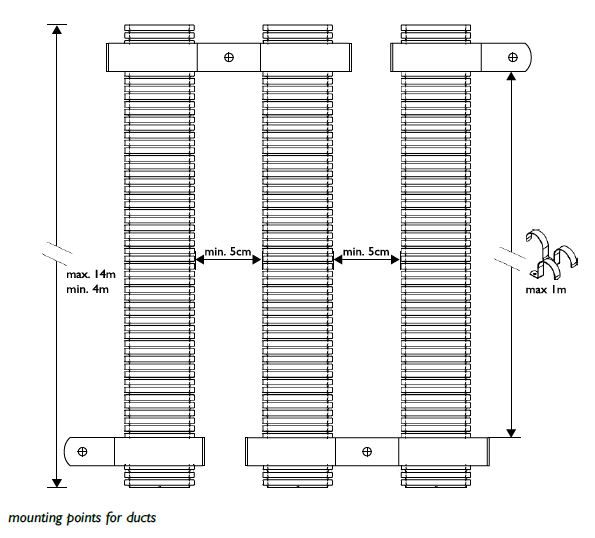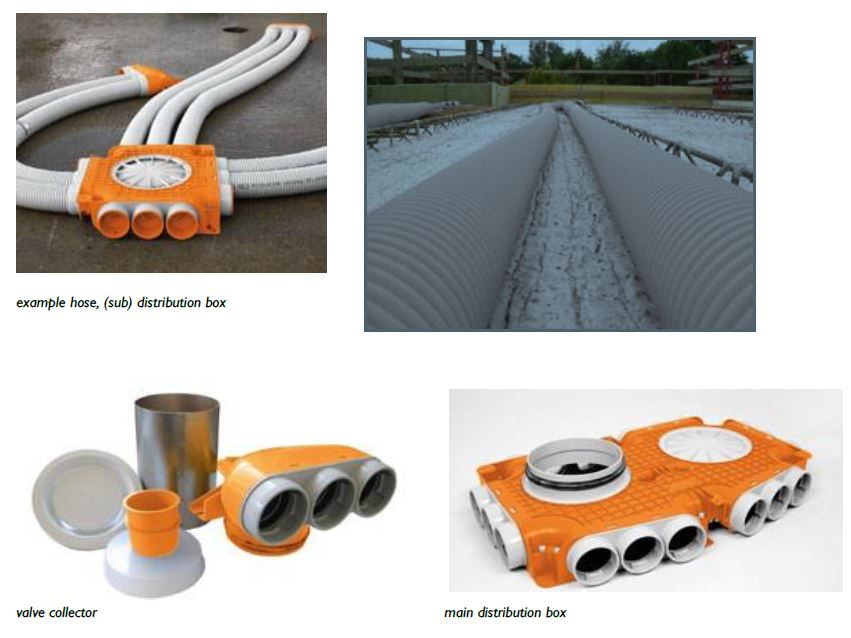(Meant for embedding in the concrete floor)
Chapter 2
2.4.3 Embedded rectangular ducts made of hard plastic
2.4.3.1 Material quality
Plastic is used more and more for ventilation ducts.
Plastic air distribution systems are increasingly seen as an extension of the existing steel ducts for residential construction. PE or polyethylene is used to manufacture these air ducts. It is possible that the ducts are fitted at the factory with antistatic and antibacterial additives. The ducts are suitable for temperatures between -20 °C to +60 °C.

2.4.3.2 Wall thickness
Depending on the type, the average wall thickness is approximately 5 mm.
2.4.3.3 Connections
Connections to the main/sub distribution boxes and valve collectors are made by a click connection with rubber seal. This creates a watertight connection so that cement water cannot penetrate the duct. Normally no connections are made to connect duct sections to each other, the ducts are expected to be directly connected to distribution boxes and valve collectors.
2.4.3.4 Dimensions
Plastic distribution systems are made in various shapes and dimensions. The most common form is a round duct with the possible dimensions: ø50, ø63, ø75 or ø90 mm.
2.4.3.5 Length of duct
Ducts are delivered on a roll.
2.4.3.6 Main (sub) distribution box
All the valve collectors on the same floor are connected to the main distribution box, and there is also a connection for the spiral flanged ducts.
2.4.3.7 Connecting collectors and connection sleeve
For the connection of valves there are valve connection collectors. Depending on the air volume, these are equipped with 1, 2 or 3 ducts, which run to the main (sub)distribution boxes.
2.4.3.8 Airtightness
Properly connected ducts on the collectors/distribution boxes comply with airtightness class C as a minimum. This also makes it possible to use the ducts in, for example, suspended ceilings in renovation projects.
2.4.3.9 Bends
There are basically no bends available for the flexible ducts. Bends and obstacles are avoided by leading the flexible hose along them. Vertical bends must always be guided.
2.4.3.10 Seal
The unused openings on the distribution boxes and collectors are sealed with the plastic caps supplied. The unused openings in the distribution boxes at the top/bottom are sealed with the supplied mortar caps.
2.4.3.11 Mounting
The embedded ducts must be fixed to the concrete floor or formwork in such a way that the duct parts cannot float during the pouring of the concrete. This is done by means of special brackets suitable for these plastic ducts, which are attached to both sides of the duct with anchor plugs to the concrete or formwork. There are several methods of adequately fixing the duct, but the duct must be fixed at most every 1 metre. (See picture below).

The various collectors and distribution boxes must be secured separately using the fitting points provided on these items. Damaged parts may not be assembled and must be replaced. All openings should be closed by plastic caps/covers. The manufacturer's instructions should always be followed for correct assembly and fixing.

- 2.1.1Rectangular ducts made of galvanised steel
- 2.1.2Embedded rectangular ducts of galvanised steel for residential construction and floors equivalent to residential construction
- 2.1.3Circular ducts made of galvanised steel
- 2.1.4Oval ducts made of galvanised steel
- 2.2.1Rectangular aluminium ducts
- 2.2.2Circular aluminium ducts
- 2.3.1Rectangular ducts made of stainless steel
- 2.3.2Circular ducts made of stainless steel
- 2.4.1Rectangular ducts made of hard plastic
- 2.4.2Circular ducts made of hard plastic
- 2.4.3Embedded rectangular ducts made of hard plastic
- 2.5.1Rectangular ducts made of mineral wool with aluminium outer layer
- 2.5.2Rectangular ducts made of mineral wool with polyester outer layer
- 2.5.3Circular ducts of mineral wool
- 2.6.1Rectangular hard foam ducts with aluminium outer layer
- 2.6.2Rectangular hard foam ducts with polyester outer layer
- 2.6.3Rectangular hard foam ducts with aluminium outer layer
- 2.7.1Internal and external coating of air ducts
- 2.8.1Thermal insulation of rectangular and circular air ducts
- 2.9.1Fire resistant insulation and sheeting of metal air ducts
- 2.10.1Assembly instructions
- 2.11.1Airtightness air transport route
- 2.12.1Internal cleanliness of new air ducts and associated fittings and components

